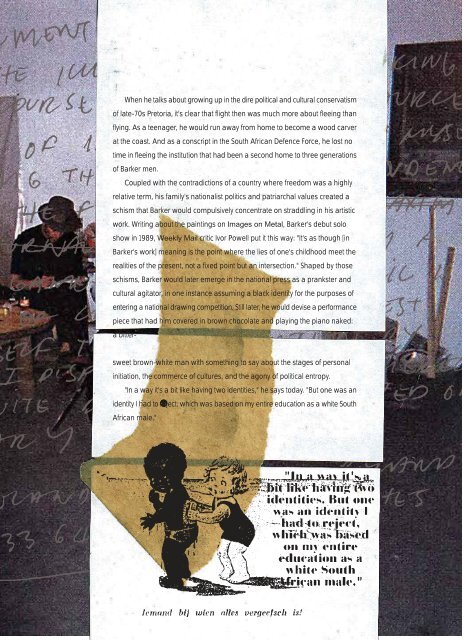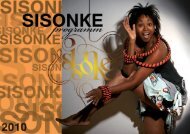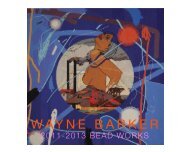WAYNE BARKER, ARTIST’S MONOGRAPH
Published 2000 in association with Chalkham Hill Press
Published 2000 in association with Chalkham Hill Press
Create successful ePaper yourself
Turn your PDF publications into a flip-book with our unique Google optimized e-Paper software.
When he talks about growing up in the dire political and cultural conservatism<br />
of late-70s Pretoria, it's clear that flight then was much more about fleeing than<br />
flying. As a teenager, he would run away from home to become a wood carver<br />
at the coast. And as a conscript in the South African Defence Force, he lost no<br />
time in fleeing the institution that had been a second home to three generations<br />
of Barker men.<br />
Coupled with the contradictions of a country where freedom was a highly<br />
relative term, his family's nationalist politics and patriarchal values created a<br />
schism that Barker would compulsively concentrate on straddling in his artistic<br />
work. Writing about the paintings on Images on Metal, Barker's debut solo<br />
show in 1989, Weekly Mail critic Ivor Powell put it this way: "It's as though [in<br />
Barker's work] meaning is the point where the lies of one's childhood meet the<br />
realities of the present, not a fixed point but an intersection." Shaped by those<br />
schisms, Barker would later emerge in the national press as a prankster and<br />
cultural agitator, in one instance assuming a black identity for the purposes of<br />
entering a national drawing competition. Still later, he would devise a performance<br />
piece that had him covered in brown chocolate and playing the piano naked:<br />
a bitter-<br />
sweet brown-white man with something to say about the stages of personal<br />
initiation, the commerce of cultures, and the agony of political entropy.<br />
"In a way it's a bit like having two identities," he says today. "But one was an<br />
identity I had to reject, which was based on my entire education as a white South<br />
African male."








